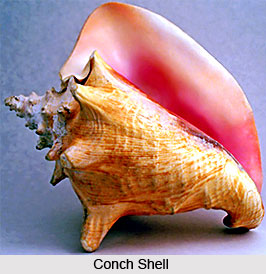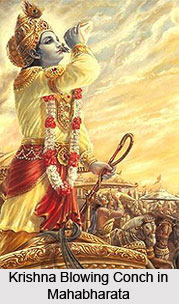 The Conch (Shankh) is an ancient wind instrument of India. However, it is not always used for musical purposes. The Conch has always had a sacred association for the Hindus. It is one of the most important expressions of worship. It is not only used as a sacred instrument to be blown during ceremonial prayers, but it is also used as a container for holy water. Where a real Conch is not available or a more durable material is desired, silver imitation of the Conch, for instance, is used as a container of holy water. Mythological and religious associations of Conch are widely known. It is one of the symbols with which Lord Vishnu is associated and one of the epithets for Vishnu is Sankhabhrit. Again, a sandal paste design of the Conch is applied by some sects of Vaishnavites.
The Conch (Shankh) is an ancient wind instrument of India. However, it is not always used for musical purposes. The Conch has always had a sacred association for the Hindus. It is one of the most important expressions of worship. It is not only used as a sacred instrument to be blown during ceremonial prayers, but it is also used as a container for holy water. Where a real Conch is not available or a more durable material is desired, silver imitation of the Conch, for instance, is used as a container of holy water. Mythological and religious associations of Conch are widely known. It is one of the symbols with which Lord Vishnu is associated and one of the epithets for Vishnu is Sankhabhrit. Again, a sandal paste design of the Conch is applied by some sects of Vaishnavites.
The Conch is quite naturally associated with the ocean. Thus it is in keeping with reason to state that the instrument must have been first used in civilizations by the ocean side. It is, however, known in areas like Peru, quite far away from the sea. As a matter of fact, one of the Sanskrit language names for Conch is Jalaja (born of water). Reciprocally, the ocean is also called Sankhin. Further, Lord Vishnu is closely associated with the milky ocean. Literary references to the Conch date back at least to the Ramayana and the Mahabharata. Visual representation of the Conch is also quite prolific. Ajanta caves (second-tenth century) exhibits a number of instances.
 Amaravati is again another example. Representations of the Conch may also be found in Bharhut (second century BC) and Nagarjunakonda (third-fifth century AD).
Amaravati is again another example. Representations of the Conch may also be found in Bharhut (second century BC) and Nagarjunakonda (third-fifth century AD).
Most commonly, the Conch is used as a signaling instrument or a container. As instances of the former, its use as an announcer of the battle is well known. With the greater use of wood and metal, the Conch was replaced by horns and bugles. Of course, where the Conch was not available naturally and easily, animal horns and bugles must have served such a purpose. The personal associations of Arjuna with Devdatta and Lord Krishna with Panchajanya are a very familiar aspect of Hinduism.
The Conch may be blown in three ways: from the side, from the end or through an attached mouthpiece. In the first two cases, the Conch is blown into directly. In the first, the blow-hole is at the side of the Conch and in the second case at the top of the Conch. The second variety is the most commonly depicted in paintings and sculptures, while Conches with mouthpieces are to be seen in Bharhut.
The difficulty of controlling the breath and intonation has made its use as a musical instrument rare. Also its sound as a musical instrument is not rich. As a matter of fact, its musical associations are not extensive at all and perhaps, it has never attained the status of a serious musical instrument. However, through practice, it is possible to wield the Conch as quite a plausible musical instrument.




